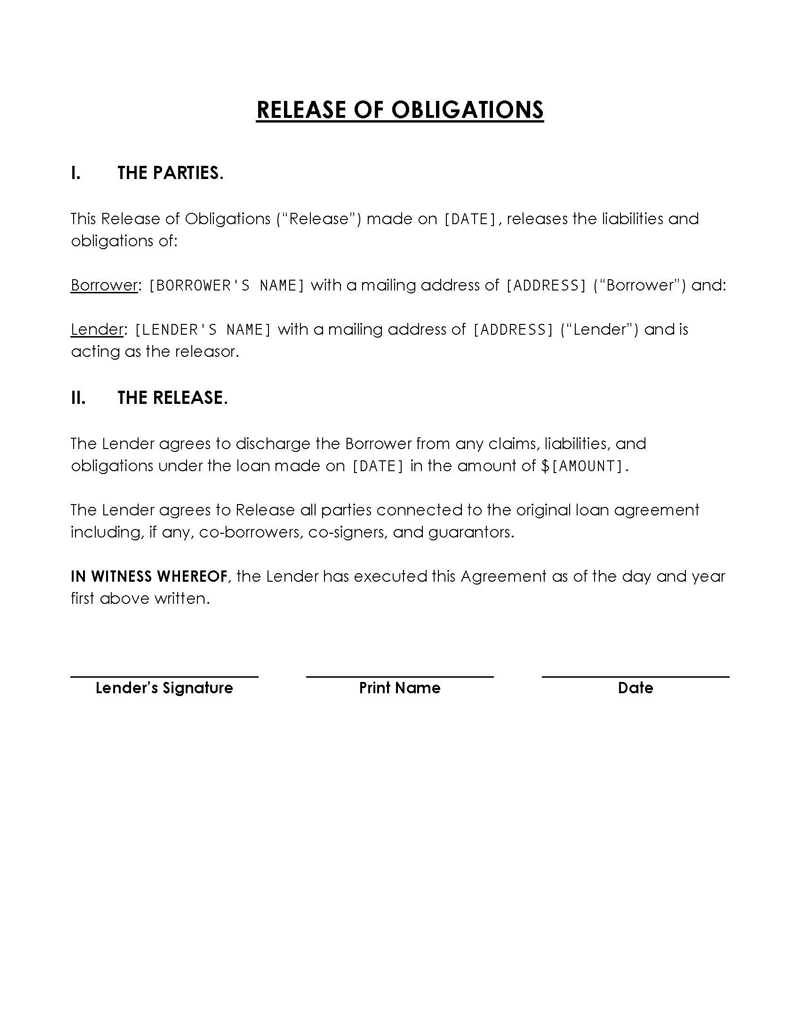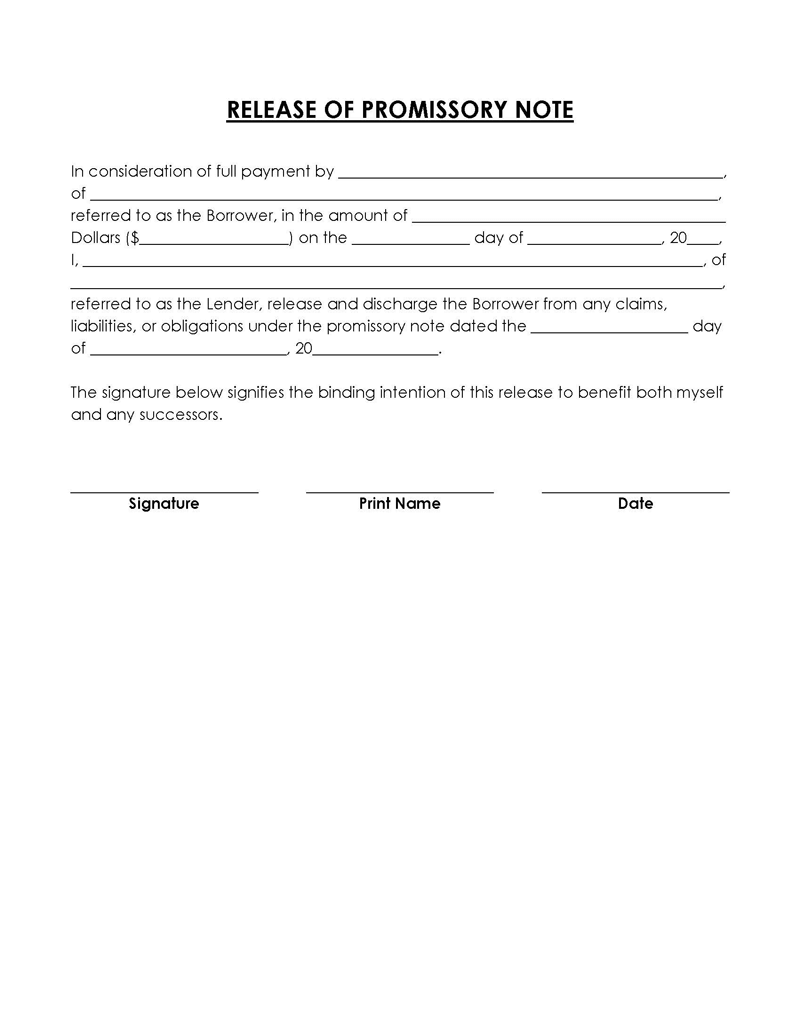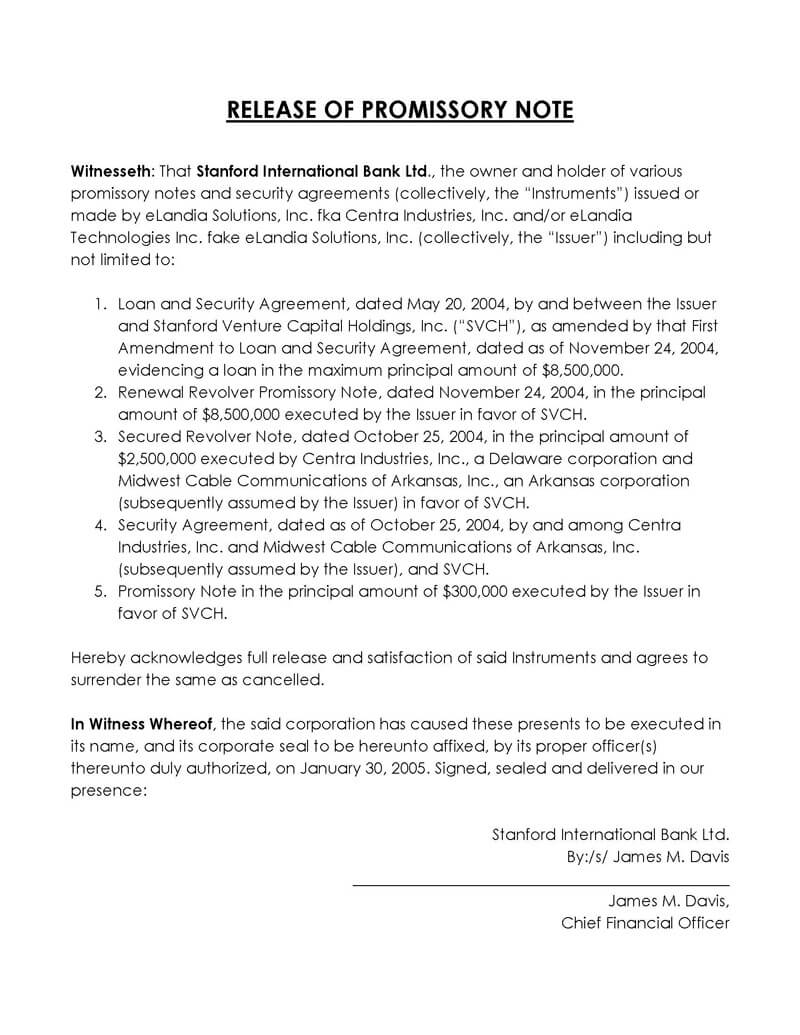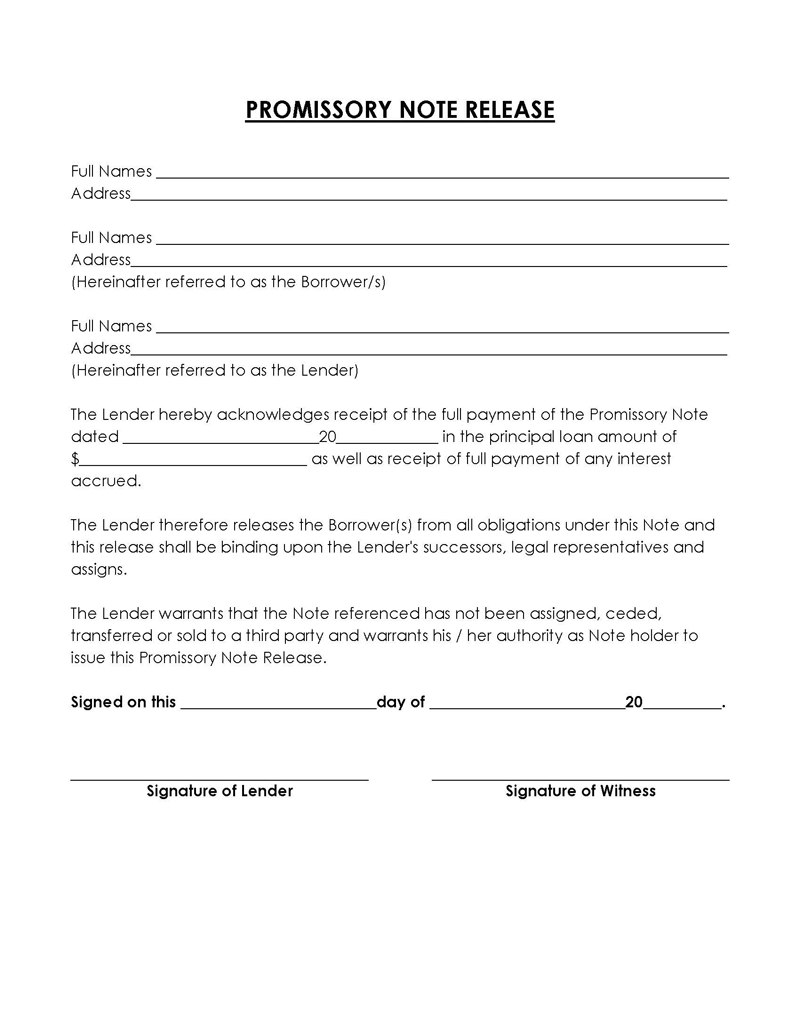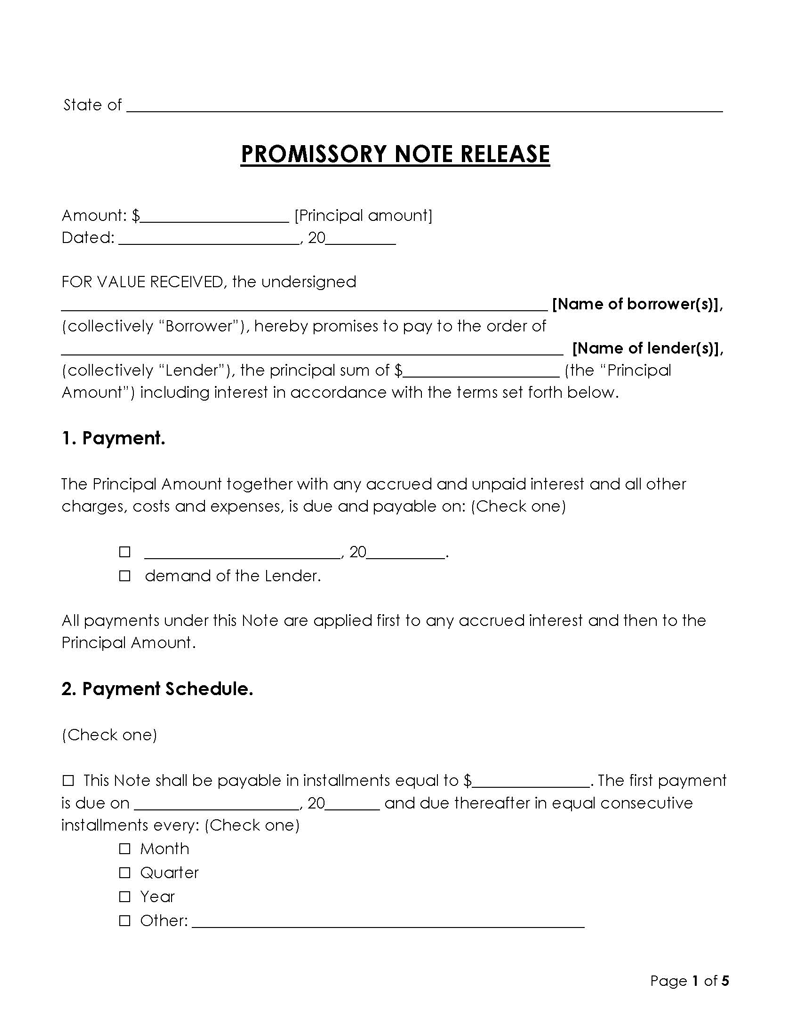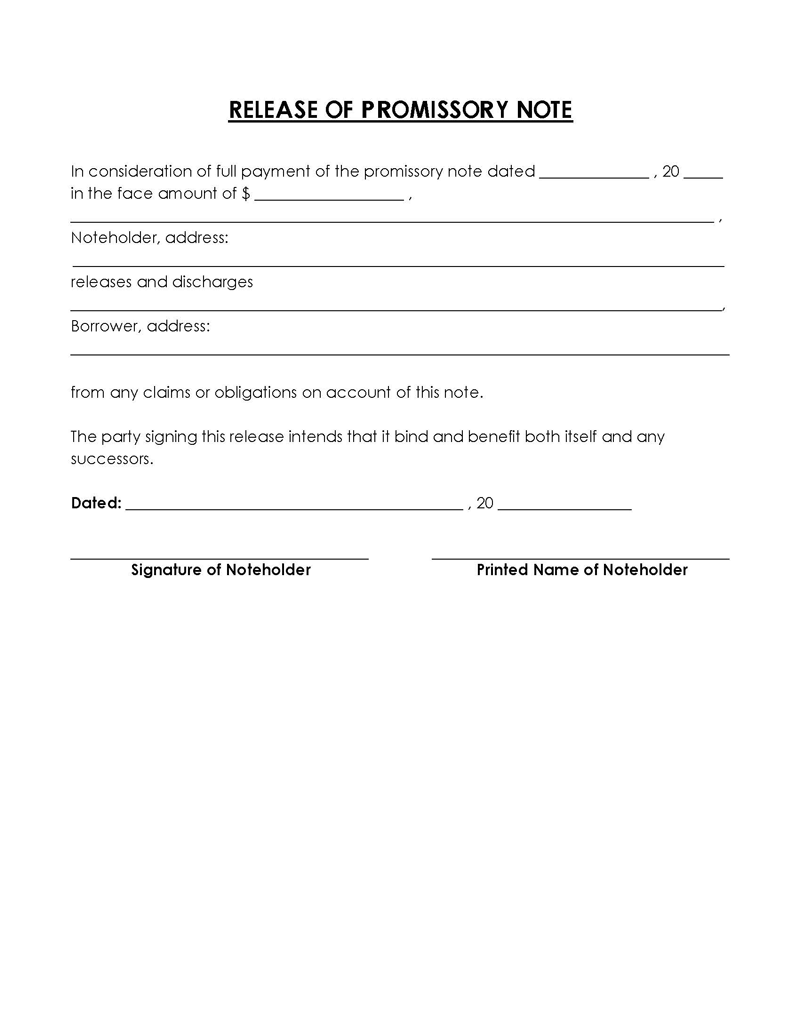Lending and borrowing are universal actions that have been around since time immemorial. And it usually involves two people, a lender, and a borrower, who agree to a loan of money or other resources.
In this kind of agreement, the lender gives something to the borrower for an agreed period. The borrower goes ahead to use the lender’s property over the same period and returns it after. Although, with interest in most cases.
But like every kind of agreement, it’s always vital to document the relationship and understanding between a borrower and lender for posterity’s sake. Similarly, having an agreement document will come in handy in case of legalities and other unforeseen issues that may arise after the agreement.
And that is why a release of promissory note is used in this kind of agreement. The form is a legal document that indicates that a borrower has completely repaid a loan to their lender after the borrower has made the final agreed-upon payment.
By getting a release of the promissory note, the borrower can be sure they are no longer bound to any obligations or liabilities to the lender.
In other words, it’s proof that the borrower has fully repaid all their debt to the lender, and the lender also agrees.
This article will discuss the promissory note release form, its importance, how to create and fill one, and all other necessary information about this legal document.
Release of Promissory Note Templates
What is a Release of Promissory Note?
As earlier stated, a release of the promissory note is a legal document representing the agreement between a borrower and lender after all terms have been met. It’s used to show that a borrower has refunded all the loan (and interest) they got from a lender, and they are no longer liable to any clause from the agreement.
Once the creditor prepares and signs the release form, they are legally obligated to return any property or asset used as collateral by the borrower.
As a debtor, you should get a promissory note after repaying all your debt in full to protect yourself from legal actions or similar issues in the future. However, you must ensure you are satisfied with the document terms, and you and your creditor sign the note for it to be legally binding.
In many cases, a promissory note can be used to represent an IOU. An IOU is a document stating the existence of a debt between two parties. However, an IOU is usually viewed as an informal written agreement, so a legal agreement like a promissory note can double as an IOU.
Usually, you don’t need to have any witnesses when signing a release unless your lender requests one. Afterward, it becomes your proof of complete payment that you can attach to the original agreement note for your records.
Circumstances for Release of the Promissory Note
Usually, a creditor and debtor sign a release of promissory note after the latter has paid their debt in full. However, there are some instances when a lender can issue a waiver to their debtor without the borrower fully repaying the loan.
For instance, if a lender forgives the borrower’s debt before the debtor repays in full, the lender needs to issue a release of the promissory note to indicate that the rest of the debt has been canceled. However, an early release like this can raise questions from the Internal Revenue Service (IRS), which can consider it a taxable event. Subsequently, the IRS will determine whether the debt forgiven will be taxed as the debtor’s income or as a gift. In essence, the debtor may end up paying an income tax or gift tax from the total amount of debt forgiven by their creditor.
However, it is essential to note that if a creditor dies, the debtor still has to pay the loan. But the loan shall be waived by law if the creditor has stated otherwise in a note before dying. If the dead lender includes the waiver, the person in charge of the creditor’s estate or the letter’s receiver will sign the debtor’s release. And if the lender does not state it, the borrower pays their debt – which will become an asset added to the lender’s estate.
How to Use a Release of Promissory Note
Using a release of promissory notes seems straightforward in theory. However, there are essential parts that both creditors and debtors must pay attention to when working with the release form. You should:
Step 1: Ensure you’re satisfied
Once you sign a promissory note release, there’s no going back. So, as a creditor, ensure you are comfortable with the repayment plan, tenure, and the associated interest (if any) before issuing a release note to your borrower. Similarly, the debtor should check every detail in the agreement, including the interest rate, repayment plan, and other clauses or liabilities, before appending their signature.
It is important to note that once the lender and their debtor have agreed to a release of the promissory note, they are both released from the initial binding agreement. In essence, the note becomes entirely null and void afterward.
Step 2: Address any liens
Suppose the borrower used their property or another asset as collateral for the loan. In that case, it must be clearly stated in the promissory note, and any lien on such a property should be terminated or canceled. By doing so, the debtor gets their security back since repayment has been completed.
Step 3: Get it notarized
Notarizing a promissory note release form isn’t mandatory, but if you can afford it, you should proceed. Notarizing the document will serve as extra protection from unexpected issues that may arise in the future. However, if you’re not notarizing the document, you should delete the paragraph about a notary.
Release of a Secured Promissory Note
As earlier stated, a lender can request security (or collateral) from a borrower before granting a loan. This kind of loan is called a secured loan. But a promissory note works the same way for secured and unsecured loans.
So, for a secured promissory note, the creditor must release the debtor’s collateral on the conditions:
- The collateral is the borrower’s personal property. In this case, the creditor should execute a release of lien or discharge of security agreement.
- The collateral is real property with a mortgage. In that case, the creditor should issue a release of mortgage with the release document.
- The property is subject to a deed of trust. In that case, a deed outrightly transferring the property to the debtor should be executed by the trustee.
How to Fill a Release Form of Promissory Note
Now that you’re ready to fill a release note, here are the essential details you should include in your document:
Provide the borrower’s information
The borrower’s identity should be fully disclosed in the release. Don’t leave any detail out. Check that the information below is clearly stated:
- Name: The borrower’s full legal name(s). Use the first name, middle name, and last name format.
- Mailing address: The full address of the debtor. This should include the city, state, zip code, phone number, and email address.
- An amount that has been paid: This is the total sum the debtor has paid during the loan duration (including interest). And it must be fully stated.
- State the date the note was fully paid: The last deposit or repayment date for the release form to be signed.
Provide the lender’s information
Like the borrower, the lender’s details should also be highlighted in the release form:
- Name: The creditor’s full name is in the first, middle, and last name format.
- Mailing address: The lender’s full residential and mail address. This should include the city, state, zip code, phone number, and email address.
- Date of the release: The date the release is to be signed in MM/DD/YYYY format.
Signatures
It’s the rule of thumb that any legal or agreement document must be signed by the parties involved. In this case, both the borrower and lender must legally sign the release. The signatures include:
- Lender’s signature
- Date of signature in MM/DD/YYYY format.
- Lender’s printed name
Both parties must keep a copy of the completed promissory note for record-keeping. The borrower should get the original copy, while the lender gets the duplicate.
What to Do after Signing the Promissory Release Note
Once the creditor and debtor have signed a promissory release note, they should attach it to the original promissory note signed at the beginning of the lending relationship and file both documents away.
Usually, there may not be a need for it in the future, but keeping old documents is a wise way of protecting yourself from unseen issues. For example, if there is an unexpected tax audit, you will need the promissory note for verification.
At other times, there can be discrepancies with records on one side. Again, having your document will help you clear such errors.
Ultimately, you’ll be able to prove that your debt has been repaid in full and can resolve any clerical, legal, tax, or similar issues that may arise later.
Promissory Note Release Example
On the 12th of February, a payment for a loan of $600 was paid to Ethan Sawyer. The borrower, Dan Walker, had initially borrowed $530 on the 15th of September 2019. This met the agreement of paying with an interest of $80. With this note, Dan walker is, therefore, released of all loan obligations.
Print name: Dan walker(borrower)
Signature: ____________
Print name: Ethan Sawyer(lender)
Signature:___________
Promissory Note Release Forms
A promissory note release form is essential for every lending relationship. It serves as a cover for the borrower and proof that both the lender and borrower can hold on to. You already know what the form entails and how to fill it accordingly.
The good part is that lenders don’t need to create a promissory note from scratch because we have a free downloadable template you can use for your lending transaction. All you need to do is visit our website and get your most preferred sample.
You’ll also find these forms in PDF, MS Word, Google Docs, etc. The ready-to-download forms will make your agreement process easier and faster. You’ll also be confident of having a promissory form that meets the expectations of the law and a government tax agency like the Internal Revenue Service (IRS).
Free Template
Free Forms (by State)
Some Quick Tips
Here are some extra things to do and look out for when preparing and signing a promissory note release:
- If the noteholder signing the release is one person, delete any possible reference to more than one person. For example, replace “we” with “I” to indicate there’s only one principal noteholder.
- Do away with confusion when writing a release form. Be as straightforward as possible with all the details and avoid retractions as much as possible.
- Get it right from the start by having all the necessary information ready. It would be best if you also read over the document to ensure you didn’t omit details or commit any grammatical and related information. It’s better to find an error and correct it before signing the form than to find out after it has been signed and become legally binding.
- Ensure the correct address of both the lender and borrower is in the release form. Also, enter these addresses legibly in the document. Then, should one or both parties want the other person’s address, it will be available on the document. Interestingly, the document has blank spaces for both parties to write down their address.
- It is recommended that both the noteholder and borrower provide registered mails that will receive the final release form. While this is not mandatory, it can prove that the lender sent the document to the borrower since registered mails have verifiable records. Doing so will also go a long way in protecting either party if there are any disputes or issues in the future.
- Alternatively, both parties can provide their email addresses to receive the release form. However, ensure both email addresses are active to receive the document.
Final Remarks
A release promissory note is inevitable in every lender-borrower relationship for so many reasons. On the one hand, it represents satisfaction on the side of the lender (or noteholder) that a debtor has paid all their debt. On the other hand, it protects the borrower from any liabilities or disputes that may arise in the future. It also helps them get their secured property or collateral if they had one at the beginning of the agreement.
Besides the two parties, a promissory note release form will come in handy during tax checks or other legalities from the government, especially if the lender forgives the borrower of their debt or dies after issuing the loan.
The borrower and lender must complete the document, and both parties must duly sign and date it to become legally binding. There are also essential details that both parties must provide, including their full names, contacts, and addresses. Ensure you fill in all information correctly and proofread the document for grammatical or spelling problems.
We have ready-to-download promissory release note forms to simplify the documentation process. You can get a copy on our website and enter the necessary details on the go. Doing so will save you time and assure you of the utmost legal compliance.
